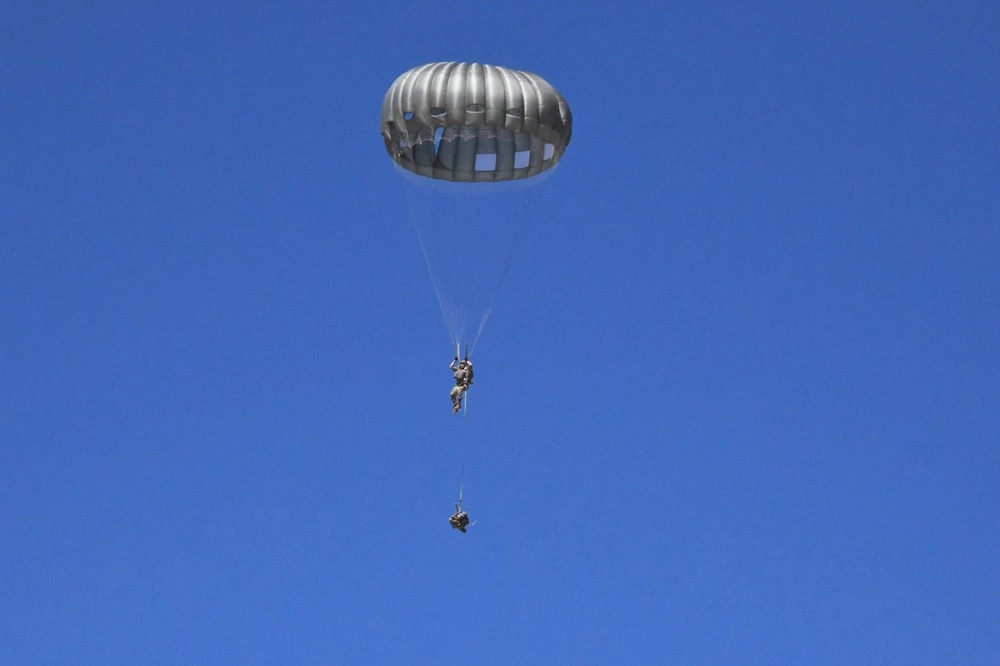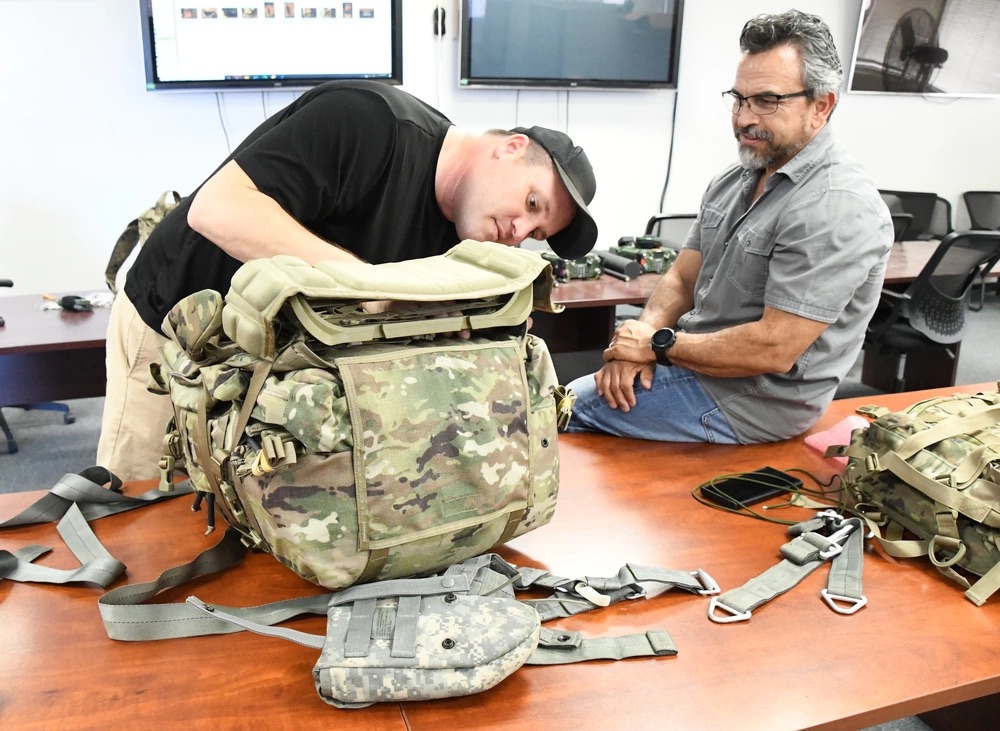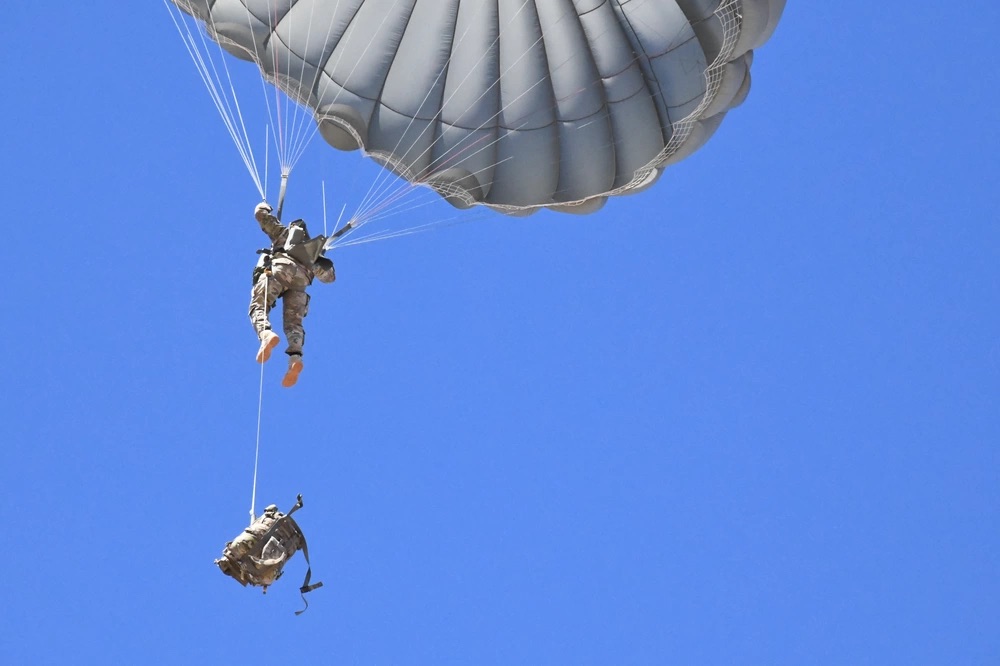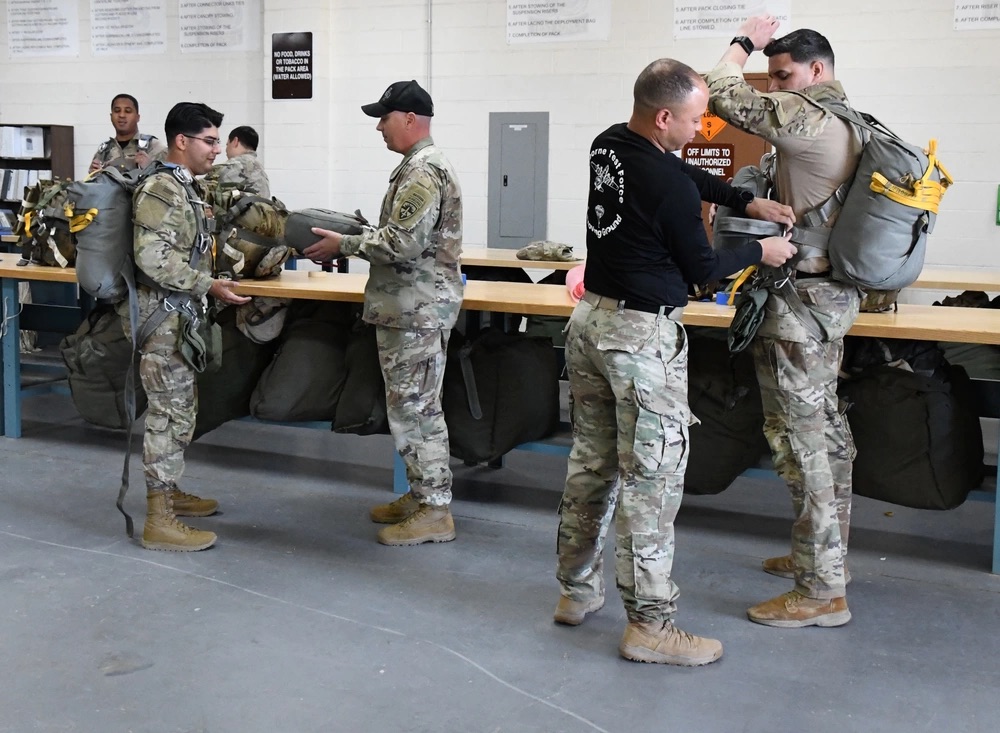The U.S. Army Airborne Test Force (ATF) located at Yuma Test Center, Yuma Proving Ground, recently tested program of record Manpack radios, the AN/PRC-158 and AN/PRC-162, managed by the Product Manager Handheld, Manpack, Small Form Fit (HMS) inside the Army’s newest Radio Carrier Rucksack (RCR) solution. The RCR, developed and produced by the Natick Soldier Systems Center, was stressed in combat-realistic scenarios by the center to determine if the RCRs could safely support parachute operations without damage to radios or the ruck.

Soldier feedback using the legacy radio rucksack over several years of test events indicated that a solution with better weight balance, comfort, and heat dissipation was required for the user. PdM HMS initiated a competitive market research strategy, which brought a variety of industry and government rucksack solutions to Soldiers during 2022 and 2023 that led to the selection of the currently tested RCR solution.
“The competitive process really drove industry innovation, challenging the community to develop a best all-around rucksack solution in support of Army combat operations while carrying our modernized communications equipment,” said Derek Harberts, deputy PdM HMS.

“What we saw during this test are the results of a successful competitive process providing the all-around best-value to the Soldier and the taxpayers.”
The current design leverages modifications to the existing design of the Modular Lightweight Load-carrying Equipment assault pack currently fielded across the Army. Compared to the legacy RCR, the improvements allow securing the radio to the pack frame for better weight, balancing, and cooling. Modifications to the ruck allow better access if the radio needs to be carried and operated inside the bag as well as improved stowage and access for radio ancillary and mission equipment.

“The radio harness allows the radio to be connected to the existing assault frame, while the side pouches allow for individualized space to store antennas away from other equipment and gear,” explained Bob Cohen, HMS Manpack Lead Test Engineer.
“There’s additional space in the bottom compartment that can be used to individually store spare batteries and other ancillary equipment for ease of access.”
In all, the RCR will carry the radio, a battery, an antenna, and the Soldier’s basic load of individual equipment.

Leading up to the test, Soldiers with the ATF team started by packing the rucks as they would operationally under the direction of ATF Soldier Sgt. 1st Class Cody Lavalla.
“The configuration of these rucks is slightly different then the currently issued rucks,” tells Lavalla, “We are going through the process of figuring out how to rig the harness single point release to the ruck so all the equipment will survive the jump and is safe for the jumpers.”
The harness single point release is the equipment that secures the ruck close to the jumper’s body during most of the jump and is designed to be lowered on a release line away from the jumper by pulling a release handle just prior to landing.
When the Soldiers were about 150 feet from the ground, they lowered the rucksack carrying the radio using the lowering line, making it about 15 feet below them when they landed.
“We don’t want the ruck still attached to us when we prepare to land on the ground, or we risk injuries as we do our Parachute Landing Falls,” explained Lavalla. “We pull on the release handle and the ruck falls away from our body but is still attached to us via the lowering line so the equipment is out of the way when we are ready to land. It is nearby to have access to the equipment quickly if needed once we are on the ground.”
ATF Soldiers performed several jumps throughout the week for the safety confirmation tests. A team met them on the ground to ensure their safety and monitored the jumps.
Afterwards, Air Delivery Test Officer Faith Harbolt, ATF and members of the HMS team inspected the radios to see how they held up to the test.
“The test went well. The results of the test demonstrated that the rucksacks successfully secure and protect the radios during airborne operations. There was no damage to the rucks or radios observed during the inspection that occurred after the test was complete,” said Lavalla.
The improved rucksack will be fielded to units receiving Manpack radios starting early next calendar year. When fielded, these items will be used by units such as the 82nd Airborne during combat operations.
Story by Ana Henderson, U.S. Army Yuma Proving Ground


another tiny static line pack like the molle 4k. In real life a paratrooper needs at least 3 days of bullets, batteries, water, and food. not happening without a sizable ruck.
mehmaster,
I have to respectfully disagree with you. First, the MOLLE 4000 is actually larger than the ALICE Large. It is a full-sized rucksack by any measure. Not “tiny” at all. Although the article muddies the water by referring to the current “assault pack” and “assault frame” in the text, I don’t think that they are referring to the actual, small, issue, Assault Pack that comes with an internal sheet frame at all. The pack shown has an external DEI 1606 frame just like the MOLLE 4000. In terms of the bag size, it is hard to be sure from the pictures provided, but it appears to be at least as big as the MOLLE Medium – if not bigger.
More than that, I disagree with your idea that the solution paratroopers’ need is an even larger rucksack. No thanks. In fact, taking as much weight as possible off the jumpers – as much as possible – is the better way to go. Way back in the 80s, we did Airfield Seizures without rucks – minus a few Leaders/RTOs. The key was speed and violence of action to put the airfield under new management and back into service. The goal was to do that and be landing friendly aircraft on the runway within 30 minutes.
That required troopers to move quickly to secure multiple objectives, not immediately turtle up with an overloaded ALICE and crawl along at a snail’s pace. I assume that the standards for airfield seizures are similar today. Sustainment loads can be airdropped or airlanded to supplement what the troopers have to carry that is actually mission essential.
Even for other Airborne missions not under the same strict time constraints, classic Airborne doctrine is to cache everything not needed right away at the initial assembly areas so that the troopers can move rapidly to secure their objectives – unhindered by anything extraneous to the immediate mission. That would include sustainment loads of any kind. Those can be retrieved later as required.
TLB
And another thumbs-down from mister mehmaster because…- it’s good when life is certain. Found that my Mystery Ranch 6500 easily met the demands of our expectations of carrying three/four day’s worth of bullets, batteries, water and food.. And if l load-managed properly, even had room for any potential SSE loot as the top lid detached from the pack as to also function as a waist pack.. Nice touch, Mister Gleason and Co. Thank you for your insight, Mister Baldwin.